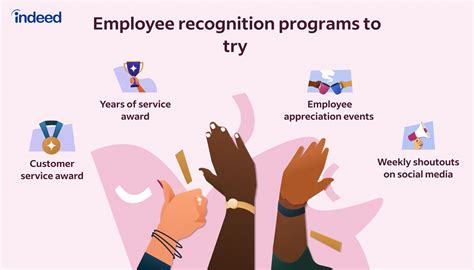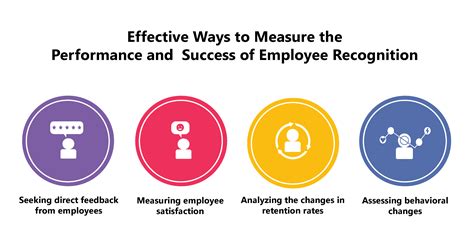The Importance of Recognition in the Workplace
Receiving recognition in the workplace is essential for employee engagement, productivity, and morale. It is not just about receiving praise; it is about feeling valued and appreciated for the effort and hard work put in towards the growth of the organization. The importance of recognition in the workplace cannot be emphasized enough, as it boosts employee confidence, leading to better performance, productivity, and retention rates. Hence, it is essential for employers to recognize their employees’ efforts to foster a positive work environment.
Recognition programs in the workplace can come in various shapes and forms. These include verbal praise, certificates, bonuses, promotions, and public recognition among colleagues and upper management. These programs help to acknowledge the contribution made by employees, boosting their morale and motivation to continue striving towards the company’s goals. Employees recognize that their efforts are noticed and valued, leading to a sense of ownership and loyalty towards the organization.
One of the essential aspects of recognition programs is to ensure that they are consistent and inclusive. Consistency means that the program should be an ongoing process and not just a one-time event. It should be built into the organizational culture, promoting continuous feedback and appreciation. As for inclusivity, recognition should not be limited to certain levels or job positions but should be available to all employees regardless of their social status within the organization.
Another crucial factor that adds to the effectiveness of the recognition program is the method of delivery. There are times when praise or recognition given by a manager can come across as insincere or impersonal. To avoid this, employers can personalize the recognition process by using specific examples of the employee’s contribution or offering the employee a chance to choose how they want to be recognized. A personalized approach to recognition can make a world of difference in the employee experience, ultimately leading to greater job satisfaction and employee retention.
Recognition in the workplace also fosters a healthy work environment by promoting a positive atmosphere of collaboration and support. Employees recognize that their contributions are essential to the success of the organization, leading to a greater sense of purpose and belonging. Recognition programs can help to build strong relationships between employees and managers, improving communication and collaboration. With a positive work environment, employees will be more motivated to work harder and give their best to achieve the organization’s goals.
In conclusion, recognition is a crucial aspect of employee engagement and retention. When employees feel valued and appreciated, they become more productive and motivated to work harder. Employers can create a recognition program that is consistent, inclusive, personalized, and promotes a positive work environment. Recognition is not just a form of praise; it is a means of building a committed and productive workforce that is essential to the success of the organization.
Types of Recognition That Employees Appreciate
Recognition is a fundamental requirement that every employee expects from their organization. It is an important factor that drives employee motivation, engagement, and loyalty. However, the type of recognition that employees appreciate varies from person to person. Some prefer public acknowledgement, while others prefer private recognition. There are various types of recognition that employees appreciate, and in this article, we will discuss the top four types.
1. Verbal Recognition
Verbal recognition is a simple yet effective way to show employees that their hard work is appreciated. Positive feedback, such as saying “thank you” or “well done,” can increase an employee’s motivation and commitment to their work. It is essential for managers to recognize their employees’ hard work, contributions, and achievements on a regular basis. A manager who frequently provides verbal recognition can create a positive and encouraging work environment.
2. Non-Monetary Rewards
Non-monetary rewards are another type of recognition that employees appreciate. They are rewards that do not involve cash payments. Instead, they are based on intangible benefits such as recognition, praise, and appreciation. Some examples of non-monetary rewards include flexible schedules, extra time off, training programs, and opportunities to work on exciting projects. Non-monetary rewards are an excellent way to show appreciation for an employee’s hard work and provide them with a sense of accomplishment and fulfillment.
Non-monetary rewards have become increasingly popular in recent years, especially among millennial and Gen Z employees who prioritize work-life balance and personal growth. By providing non-monetary rewards, employers can create a positive workplace culture and increase employee engagement and satisfaction.
3. Public Recognition
Public recognition is a powerful way to motivate employees and show that their hard work is valued. It involves recognizing employees’ contributions in a public forum, such as a team meeting or company event. Public recognition can range from a simple thank-you note to a formal award ceremony. It provides employees with a sense of pride and accomplishment and can encourage them to continue to strive for excellence. Public recognition can also increase team morale and encourage healthy competition among colleagues.
4. Personalized Recognition
Personalized recognition is when a manager or employer recognizes an employee’s hard work in a meaningful and individualized way. It involves taking the time to understand an employee’s strengths, career goals, and personal interests. Some examples of personalized recognition include a handwritten note, a personalized gift, or a promotion or raise based on an employee’s specific accomplishments. Personalized recognition can deepen employee engagement and loyalty and create a sense of belonging within the organization.
In conclusion, recognition is an essential factor in driving employee motivation and engagement. By providing various types of recognition, such as verbal recognition, non-monetary rewards, public recognition, and personalized recognition, employers can create a positive and productive workplace culture that attracts and retains top talent.
How to Create a Recognition Program That Works

Recognition is an important aspect of any workplace. It is a powerful way to motivate and engage employees and has been shown to increase productivity, job satisfaction, and loyalty. However, simply saying “thank you” or “good job” isn’t enough to build a successful recognition program. To create a program that works, here are some practical tips to keep in mind:
1. Define Success
Before creating a recognition program, the first step is to define success. Determine what goals you want to achieve with the program. Is it to increase employee motivation, lower turnover rates, or improve productivity? With clear objectives, it is easier to identify the behaviors and actions that align with your company’s goals. It is also important to define the target audience, the types of recognition, and the frequency of recognition.
2. Involve the Team
Recognition programs should be designed with input from all levels of employees, including managers, supervisors, and frontline leaders. Involve employees in the design process and seek feedback on what types of recognition they value most. They may also have suggestions for how to implement the program in a way that feels genuine, relevant, and effective. Ensuring that everyone is on board with the program and feels invested in its success is a crucial step in making it work.
3. Make it Meaningful

One of the most important aspects of a successful recognition program is making it meaningful. Recognition that is generic or insincere can actually do more harm than good. It is important to understand what motivates each individual employee, their values, and what they find meaningful. Personalized recognition, whether it is through a handwritten note, a shoutout during a team meeting, or a small gift that reflects the employee’s interests, is much more impactful and creates a sense of belonging and appreciation.
Another way to make recognition meaningful is to connect it with company values and goals. Use recognition as an opportunity to reinforce and celebrate behaviors and actions that align with the company’s mission and vision. This not only reinforces positive behavior for individual employees but also communicates to the wider team what is valued, strengthening the sense of purpose and cohesion.
4. Be Consistent
Consistency is key when it comes to recognition. A one-time recognition event can be a nice gesture, but it doesn’t create lasting change. Recognition should be part of the company culture and integrated into daily routines. This could be through regular shoutouts during team meetings, a recognition board where employees can publicly recognize one another, or even a digital platform that allows for real-time recognition. Regardless of the method, regular recognition signals that it is important and reinforces behaviors and actions that support the company’s goals.
5. Measure Success

Finally, the success of the recognition program should be measured and evaluated. This doesn’t necessarily mean tracking the number of recognition events or the total cost of the program. Instead, it is about assessing whether the program has achieved the desired goals. This could be through employee surveys, focus groups, or analyzing data such as retention rates, productivity, and job satisfaction. Measuring success allows you to identify what is working and what is not, and make adjustments to the program as needed.
By keeping these five tips in mind, your recognition program has the potential to be a powerful tool for motivating and engaging employees and driving success for your company.
The Role of Managers in Recognizing Employees
Recognition is an essential aspect of the workplace and is crucial for employee motivation and overall job satisfaction. As a manager, recognizing employees for their hard work and accomplishments is an important part of maintaining a positive workplace culture. But what exactly is the role of managers in recognizing employees, and how can they do it effectively?
Providing Feedback
One of the most critical roles of managers in recognizing employees is providing feedback. Employees need feedback to understand how they are contributing to the organization’s goals and making a positive impact. Managers can effectively recognize employees by providing regular performance evaluations and feedback on their work. If an employee is excelling in a particular area, managers should take the time to acknowledge that and express appreciation. Similarly, if there is an area that needs improvement, a manager should coach and provide training to help the employee succeed.
Offering Rewards and Incentives
Another critical role of managers in recognizing employees is offering rewards and incentives. Rewards and incentives can be a powerful motivator for employees, and can help them feel valued and appreciated. Managers can offer rewards such as bonuses, gift cards, or extra time off for exceptional performance. Additionally, incentive programs can be implemented that offer recognition for meeting specific goals or milestones.
Creating a Positive Work Culture
One of the most important roles of managers in recognizing employees is creating a positive work culture. A positive work culture is essential for retaining employees, increasing productivity, and promoting job satisfaction. Managers can create a positive work culture by recognizing employees for their accomplishments, providing opportunities for growth and development, and fostering open communication. By creating a positive work culture, managers can build a strong team that is motivated and engaged in their work.
Leading by Example
Finally, one of the most critical roles of managers in recognizing employees is leading by example. Managers set the tone for the organization and its culture. They must model the behavior they want to see in their employees. If a manager recognizes employees for their hard work, dedication, and achievements, then employees will be more likely to follow suit. Leading by example is a crucial aspect of recognizing employees and promoting a positive work culture.
In conclusion, recognizing employees is an essential aspect of maintaining a positive workplace culture and promoting employee motivation and job satisfaction. Managers play a critical role in recognizing employees, and they can do it effectively by providing feedback, offering rewards and incentives, creating a positive work culture, and leading by example. By recognizing employees, managers can create a strong team that is motivated, engaged, and committed to achieving the organization’s goals.
Measuring the Impact of Recognition on Employee Engagement and Retention
Employee recognition is one of the keys to maintaining employee engagement and retaining top talent in any organization. Research has shown that employees who feel recognized for their work are more likely to stay with their current employer and be engaged in their jobs. Measuring the impact of recognition on employee engagement and retention can help organizations understand the importance of recognition programs and create strategies to improve them.
Engaged employees are more productive, loyal, and less likely to quit their jobs. Recognition is a critical factor in employee engagement. When employees feel appreciated for their contributions, they are more likely to feel committed to the organization and their job. Recognition can come in many forms, such as bonuses, promotions, public praise, and employee appreciation events. The key is to make employees feel valued and appreciated.
There are several ways to measure the impact of recognition on employee engagement and retention. One of the most effective ways is through employee surveys. Conducting a survey can provide valuable insights into how employees feel about recognition in the workplace. The survey can ask questions such as, “Do you feel valued and appreciated for your work?” and “Do you think the organization recognizes and rewards employees fairly?” The results can help the organization understand where they need to improve their recognition programs.
Another way to measure the impact of recognition is through retention rates. Organizations that have effective recognition programs generally have lower turnover rates. Employees who feel valued and appreciated are more likely to stay with the organization and contribute to its success. By tracking employee retention rates before and after implementing a recognition program, organizations can determine the effectiveness of the program.
Productivity is also a critical factor in employee engagement and retention. Organizations that have highly engaged employees generally have higher productivity levels. Recognition can be a motivating factor for employees to be more productive and go above and beyond in their job duties. By tracking productivity levels before and after implementing a recognition program, organizations can determine the impact of recognition on productivity.
Employee feedback is another way to measure the impact of recognition on engagement and retention. Employees who feel valued and appreciated are more likely to provide feedback and contribute to the success of the organization. By soliciting feedback from employees on recognition programs, organizations can determine which programs are the most effective and make improvements where necessary.
Finally, employee recognition can also impact the overall culture of the organization. Employee recognition programs can create a positive work environment, boost morale, and increase teamwork. By tracking changes in employee morale and culture before and after implementing a recognition program, organizations can determine the impact of recognition on the overall culture of the organization.
In conclusion, recognition is a critical factor in employee engagement and retention. By measuring the impact of recognition on these factors, organizations can create effective recognition programs that lead to a more engaged and productive workforce. Employee surveys, retention rates, productivity levels, employee feedback, and overall culture are all ways to measure the impact of recognition. By taking these factors into account, organizations can create a culture of recognition that leads to employee loyalty and success.


